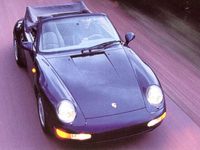New Car Review
SEE ALSO: Porsche Buyer's Guide
1996 Porsche 911 Carrera Convertible
by JOHN HEILIG
SPECIFICATIONS
ENGINE: 3.6-liter flat six
HORSEPOWER/TORQUE: 282 hp @ 6300rpm l250 lb-ft @5250rpm
TRANSMISSION: Tiptronic automatic
FUEL ECONOMY: 17 mpg city, 24 mpg highway, 15.2 mpg test
WHEELBASE: 89.5 in.
OVERALL LENGTH: 167.8 in.
OVERALL HEIGHT: 51.8 in.
OVERALL WIDTH: 68.3 in.
CURB WEIGHT: 3175 lbs.
FUEL CAPACITY: 19.4 gal.
LUGGAGE CAPACITY: 5 cu. ft. (est.)
TIRES: 205/55ZR16 (front/245/45ZR16 (rear)
INSTRUMENTS: Speedometer, tachometer, fuel level, oil pressure,
battery voltage, oil temperature, analog clock.
EQUIPMENT: Leather seats, power top, power mirrors, AM/FM stereo
with cassette, ABS, dual air bags.
STICKER PRICE: $69,845 (est.)
Driving a Porsche--any Porsche--is an exhilarating experience. You know you're at the wheel of one of the finest sports cars ever, and a lot of the people sharing the road with you are also aware of that fact. So besides having the opportunity to enjoy a fine automobile, you also get the vicarious pleasure of watching people envy you in your fun. And they don't know I don't own the car, so it's even more fun.
Our tester today is the Porsche 911 Carrera convertible. It was silver--German racing colors-with a blue top. First off, I think the car would have looked even better with a slightly lighter top, but who's complaining.
It's hard to believe that the basic 911 design (and engine for that matter) is over 30 years old. But the 1996 version is much smoother, especially around the headlights and fenders, and the engine's output has almost tripled to 282 horsepower. Handling is excellent, if a little stiff. I didn't feel the suspension was too harsh until I stepped out of the Porsche and into another tester, which felt strangely mushy. What is nice about the Porsche's suspension, though, is that it isn't too hard, just stiff enough to offer excellent handling.
Part of the solution, of course, is the rear-mounted air-cooled horizontally opposed sixcylinder engine, that offers good balance. I did feel that at higher speeds the Porsche felt slightly twitchy, particularly on rough roads. The front suspension is independent by MacPherson struts with aluminum alloy lower control arms, stabilizer bar and negative steering roll radius. In the rear, the independent multi-link long-short arm suspension has self-stabilizing toe characteristics and a stabilizer bar.
Power reached the wheels through Porsche's Tiptronic transmission that offers both automatic and manual shifting capabilities. Unlike-the Chrysler automatic stick shift, the Porsche Tiptronic's "shift" side is a vertical slot off to the right of the main shifting track. If you want to shift the Tiptronic, push the lever to the right and push it forward to upshift and backward to downshift.
OR, you can use the buttons on the steering wheel, Grand Prix style. There are two, at each end of the "T" that connects to the rim. These buttons make shifting far more convenient that using the stick, and since the Tiptronic by definition is easier to shift than a standard manual shifter, it is therefore more fun and more efficient. On the instrument panel there is the standard automatic shift indicator, but to the right of this is another indicator telling you which of the four speeds you are in at the time, whether you're in automatic or shift mode.
The transmission also appears to have an "overdrive" in the top three gears. For example, you accelerate in first, shift to second manually, and about halfway up the revs the gearbox seems to shift into a slightly higher gear, much like an overdrive.
I did notice, though, that the Porsche's shifter was less responsive than Chrysler's. This may have been a result of higher mileage on the Porsche (and probably harder use), but there was a noticeable time lag between pushing the button or lever and the car's shilling that was longer than on the Dodge Stratus.
The front bucket seats were gloriously comfortable. We used the Porsche to go to dinner after working all weekend at a local car show and flea market. Our bodies were sore. But a few miles of driving and riding in the Porsche eased some of the pain. The two vestigial rear seats are only there for effect. I wouldn't put a real human being back there at any time.
We stored some groceries in the back, which did make sense. There's also a decent front trunk in the front of the Porsche that was good for flatter items. I'm sure a carry-on suitcase would have fit in there, or definitely a duffel bag type. The front trunk is lined, protecting both the mechanicals of the car and whatever is stored there.
I liked the power top. All you do is push a button and the top drops behind the rear seat. Unlike the Mercedes-Benz SL, though, the top isn't-covered by a neat compartment when it goes down. But that's probably what the extra $14,000 is for....
What I found most interesting about driving the Porsche, other than the sheer pleasure of driving a great car, was the effect it had on the other drivers. Many would smile or wave to me, others would give me a smug look as they passed me on the Interstate. But the most fun was the drivers who decided they could keep up with me, especially the young man in the Volkswagen who drove the wheels off his car but was able to keep up. We bonded for the few minutes we were on the road together and I'd like him to know now that it was fun.



